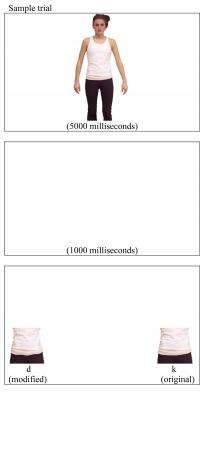(Medical Xpress) -- A small group of researchers has found that true to stereotype, people really do tend to look at women as a collection of body parts, rather than as a whole person. What’s perhaps most surprising though, is that the phenomenon is not confined to men, women do it too. The research team made up of Sarah Gervais, Theresa Vescio, Jens Förster, Anne Maass and Caterina Suitner, set out to see if the commonly held belief that women are objectified by others was true or if it was just myth. They set up experiments using undergraduate student volunteers of both genders using photographs and found, as they describe in their paper published in the European Journal of Social Psychology, that not only does the belief hold true, but that the conventional mode of viewing can be switched off given the right circumstances.
Many studies have been conducted regarding the impact feeling objectified by others has on women. Most commonly it can lead to negative body issues and eating and mood disorders. But, the researchers found, little work has been done to find out if the feeling of being objectified is something that exists only in the minds of those that feel it, or if in fact, it’s really the way people look at women.
To find out, they enlisted the help of 227 undergraduate students of both genders. Each was asked to look at photographs of people near their own age from the knees up; again, of both genders. Following the display of each photograph, each volunteer was then shown two pictures, side by side. One of the pictures was identical to the first picture shown while the other was slightly altered; the bust/chest or waist was changed just a little bit. The volunteers were asked to choose which was the same as the original. A second experiment was conducted in the same way as the first except when the side-by-side pictures were displayed, they were zoomed in to show just the torso.
In a new study that examined our cognitive process in how we perceive men and women, participants saw a fully clothed person from head to knee. After a brief pause, they then saw two new images on their screen: One that was unmodified and contained the original image, the other a slightly modified version of the original image with a sexual body part changed. Participants then quickly indicated which of the two images they had previously seen. They made decisions about entire bodies in some trials and body parts in other trials. Credit: University of Nebraska-Lincoln
After reviewing the results, the researchers found a clear difference between the way people of both genders view women. They found that the volunteers were better at recognizing body parts of women versus men when viewing both whole images, and images of just those body parts. When viewing pictures of men, they found things were reversed, most of the volunteers were much better at recognizing men if they saw the whole person.
Next, the researchers tried something else. They showed volunteers pictures of letters that were made up of other different tiny letters before showing them the pictures in the first experiments. Some were asked to identify the tiny letters inside the letters, others were asked to identify which letter the little ones formed as a whole. One forced local brain processing the other global. They found that those that were forced to think globally before viewing the photographs were much less likely to objectify the women in the pictures.
The researchers don’t know why people objectify women, but speculate that it’s either because of mating behaviors in our distant past, or perhaps because of more recent trends, such as the way modern media portray women.
More information: Seeing women as objects: The sexual body part recognition bias, European Journal of Social Psychology, DOI: 10.1002/ejsp.1890
Abstract
Objectification theory suggests that the bodies of women are sometimes reduced to their sexual body parts. As well, an extensive literature in cognitive psychology suggests that global processing underlies person recognition, whereas local processing underlies object recognition. Integrating these literatures, we introduced and tested the sexual body part recognition bias hypothesis that women's (versus men's) bodies would be reduced to their sexual body parts in the minds of perceivers. Specifically, we adopted the parts versus whole body recognition paradigm, which is a robust indicator of local versus global processing. The findings across two experiments showed that women's bodies were reduced to their sexual body parts in perceivers' minds. We also found that local processing contributed to the sexual body part recognition bias, whereas global processing tempered it. Implications for sexual objectification and its underlying processes and motives are discussed.
© 2012 Medical Xpress





















